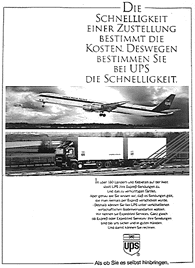
What exactly is international advertising?
By international advertising one understands advertising means (Advertisements,
TV spots, posters, radio spots) that are used in several countries, while they are
more or less made to suit the characteristics of the receivers.
In order to reduce costs, the advertising branche was more and more thinking about
standardisation of advertising over the last couple of years. Standardised advertising is
considered to be advertising means that are, except for the translation of the text, designed
internationally uniform (see fig. 5).
In order to position a brand internationally, mainly emotional consumer experiences are
used in advertising (see fig. 6). That makes sense, since nowadays most consumers are
lead by the emotional attraction of a brand, and less by its functional product characteristics.
That is, because the quality of many of today’s products is very high, therefore the risk of
buying a bad product is low. Also, the products of different manufacturers hardly differ in
functional terms. Whether you buy a dish washer from BBC or Siemens doesn’t really make
a difference.
Both are of high quality and the prices are about the same. Basically you cannot do much
wrong buying any of the two. Considering this, the emotional attraction is getting more and
more important. In other words: We decide to buy the brand that we feel most comfortable with.
Examples for attractive brands are Chanel, Nike, Coca Cola, BMW, Marlboro and Boss.
They stand for emotional consumer experiences like elegance, sportiveness, American
way of life, fun at driving, freedom and adventure, innovation. It´s getting difficult when you
try to communicate these emotional experiences internationally.
Advertising men as well as scientists have been argueing for years, wether you can use
one and the same advertisement in all coutries or you need to develop a new advertisement
for each country in order to suit the local habits and interests of the inhabitants.
Many enemies of the standardisation say that advertisements had to suit the culture of a
country in order to work at all, specially when it came to emotional advertising, since the feelings
and experiences of people would vary depending on their culture.
So why does this argument exist anyway? It's because until today we hardly have any scientific knowledge about the emotional reactions of consumers of different cultural identity. Therefore the
creative people in advertising agencies depend on speculations when developing international
advertising campaigns.
This intuitive way comes with the risk that in the end the advertisement might not work and
that the brand won’t get the intended profile across to the receiver. Because of this uncertainty,
often standardised advertisements are developed that are reduced of all elements which are
supposed to be culturally specific:
The model, the hair cut, the red dress, the way the table is decorated. Often you only see the
product in the advertisement. That, of course, appears boring and causes the ad hardly to move
the receiver emotionally.
That’s why my research topic was whether there are similarities in feelings and experiences for consumers of different cultural identity that make standardisation of emotional advertising possible.
I was especially interested to find the cultural factors that let you estimate these similarities in feeling
and experience.
In other words: What makes people react differently to emotional advertising? Their language?
Their values? Their origin? Their nationality? My Publications on international advertising will
give you answers to these questions.





